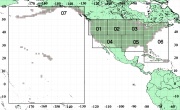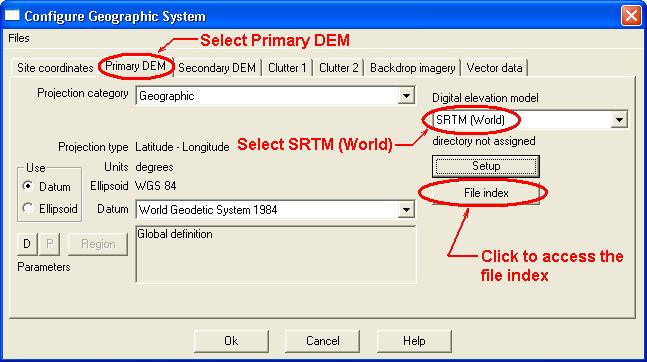Difference between revisions of "SRTM"
(→How to use the SRTM data with the Pathloss 5 program.) |
(→How to use the SRTM data with the Pathloss 5 program.) |
||
| Line 48: | Line 48: | ||
Browse to locate the '''''HGT''''' files you have downloaded (You can select many HGT files at once by holding Ctrl or Shift while selecting files). Click '''''Open''''' and the files will be added to the index list. | Browse to locate the '''''HGT''''' files you have downloaded (You can select many HGT files at once by holding Ctrl or Shift while selecting files). Click '''''Open''''' and the files will be added to the index list. | ||
| − | Note the edges of the | + | Note the edges of the SRTM file(s) and ensure that they cover the area of your project. In other words, make sure that the sites coordinates fall within the rectangle bounded by the North, South, East and West edges as listed for the SRTM file(s) in the index. |
You have now configured Pathloss 5 for SRTM terrain data. | You have now configured Pathloss 5 for SRTM terrain data. | ||
Revision as of 13:20, 28 May 2010
There are 2 verisons of the SRTM files. You can read all about the differences here http://dds.cr.usgs.gov/srtm/What_are_these.pdf, but basically if the data is available as version 2, use it. It has been cleaned up and most of the blanks, spikes and wells have been fixed.
From the NASA ftp site:
"Version 1 of the SRTM data consists of the original Digital Elevation Models produced by the SRTM project with data from the STS-99 mission in Feb, 2000, and delivered to the National Geospatial-Intelligence Agency (NGA.) These data are unedited and contain spurious data points in area of low radar backscatter such as water bodies.
Version 2 is the result of a substantial editing effort by the NGA and exhibits well defined water bodies and coastlines and the absence of spikes and wells (single pixel errors), although some areas of missing data (voids) are still present. The Version 2 directory also contains the vectorized coastline mask used by NGA in the editing, called SRTM Water Body Data (SWBD), in shapefile format.
Version 2 is a superior product and it is recommended for most users."
How to download
An easy way to download SRTM data is to use this tool http://www.pathloss.com/mapsearch.html
SRTM data are distributed in two levels: SRTM1 with data sampled at one arc-second intervals in latitude and longitude (USA only), and SRTM3 sampled at three arc-seconds. Three arc-second data are generated by three by three averaging of the one arc-second samples. The SRTM3 files are arranged by the following continents:
- Africa
- Australia
- Eurasia
- Islands
- North America
- South America
You may have to look in the neighboring continent to find the files you need (example: Middle east is in Africa)
The SRTM1 files are arranged by Regions as show in the following graphic courtesy of the NASA ftp to the right.
Data are divided into one by one degree latitude and longitude tiles in "geographic" projection, which is to say a raster presentation in no projection at all but easy to manipulate and mosaic.
File names refer to the latitude and longitude of the lower left corner of the tile - e.g. N37W105 has its lower left corner at 37 degrees north latitude and 105 degrees west longitude. To be more exact, these coordinates refer to the geometric center of the lower left pixel, which in the case of SRTM3 data will be about 90 meters in extent.
The data can be downloaded at http://dds.cr.usgs.gov/srtm/. These files are compressed using pkzip. You will need to unzip the files before they can be used.
How to use the SRTM data with the Pathloss 5 program.
Click Configure - Set GIS configuration
Click the Primary DEM tab and select SRTM (World) from the Digital elevation model drop down list.
Click the File index button and a new window will appear. In the menu of the new window click Files ,Import index and SRTM hgt files.
Browse to locate the HGT files you have downloaded (You can select many HGT files at once by holding Ctrl or Shift while selecting files). Click Open and the files will be added to the index list.
Note the edges of the SRTM file(s) and ensure that they cover the area of your project. In other words, make sure that the sites coordinates fall within the rectangle bounded by the North, South, East and West edges as listed for the SRTM file(s) in the index.
You have now configured Pathloss 5 for SRTM terrain data.
How to use the SRTM data with the Pathloss 4 program.
You will need the latest version of the Pathloss program.
The SRTM data uses the WGS84 datum. Your coordinates will be transformed automatically.
In the Pathloss program click "Configure" – "Terrain Database" and select "SRTM" from the drop down list. Click Setup Primary (or Secondary depending on your selection). Click "File" then "BIL-HDR-BLW" and browse to find and load a file with the HGT extension. The program is now setup to use the selected SRTM file.


